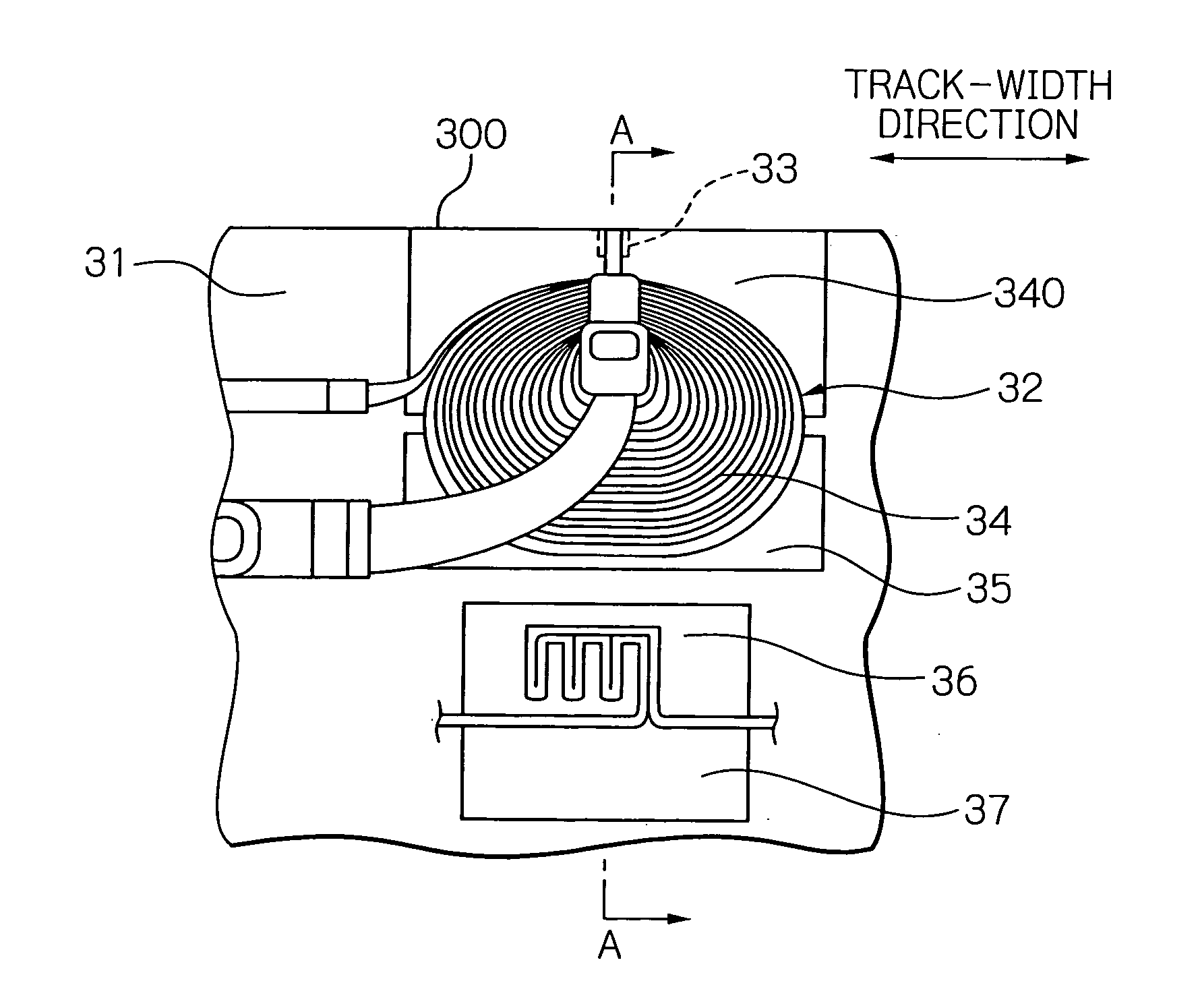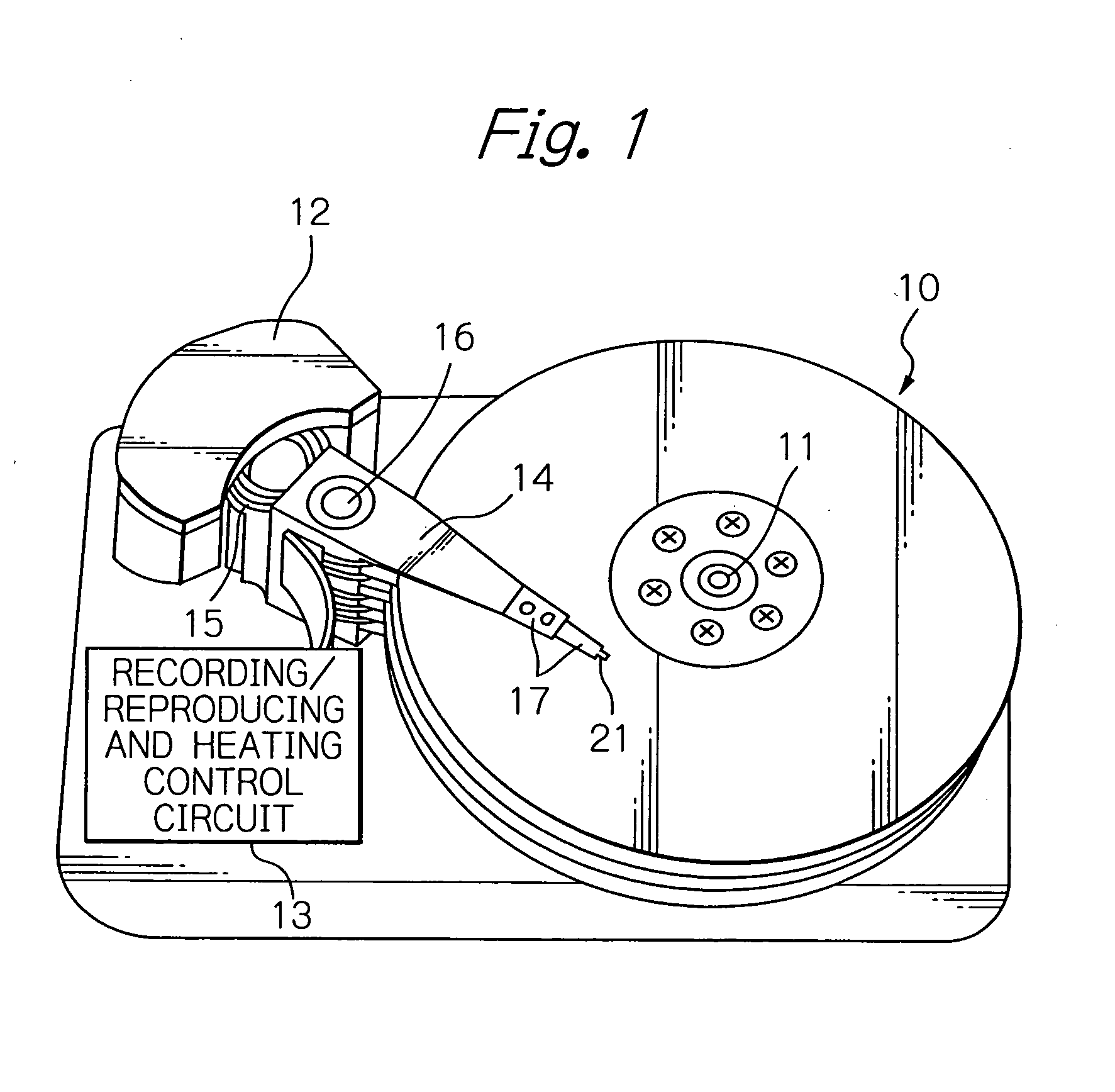Thin-film magnetic head with heating element and heatsink
a heating element and heatsink technology, applied in the field of thin-film magnetic heads with heating elements and heatsinks, can solve the problems of excessive heating physical damage or crash the magnetic disk, and increase the temperature of the heater itself, so as to improve the protruding efficiency of the magnetic head element, improve the reliability of the heating operation, and stabilize the read output
- Summary
- Abstract
- Description
- Claims
- Application Information
AI Technical Summary
Benefits of technology
Problems solved by technology
Method used
Image
Examples
embodiment 1
A Structure of an Embodiment 1
[0127]FIG. 12a shows a cross-sectional view illustrating a structure of a main part in a thin-film magnetic head of an embodiment 1 according to the present invention, and FIG. 12b shows a plain view explaining the size and position of a heater heatsink element in the thin-film magnetic head.
[0128] According to FIGS. 12a, the structure and configuration of a heating element 1200, a heater heatsink element (first heatsink element) 1201 and a coil heatsink element (second heatsink element) 1202 are almost the same as those of the embodiment shown in FIG. 4a. The heater heatsink element 1201 includes first and second heater heatsink layers as main layers. According to FIG. 12b, the heater heatsink element 1201 has a rectangular shape and a size of WHS1=90 μm and LHS1=30 μm, where the WHS1 is a length of the shape in the track-width direction and the LHS1 is a length of the shape in the direction perpendicular to the ABS (head end surface 300). The spacing...
embodiments 2 and 3
[0140] Hereinafter, the results of simulating the amount of temperature increase and the amount of protrusion in various structures of the heater heatsink element will be explained.
[0141] Table 2 illustrates the results of the simulations of the temperature increase per power and the amount of protrusion per temperature in embodiments 2 and 3. The results of the embodiment 1 are also described in the table to facilitate comparisons of values. Here, the heater heatsink element of the embodiment 2 has a monolayered structure as shown in FIG. 5c, and the heater heatsink element of the embodiment 3 has a mainly three-layered structure of the first, second and third heater heatsink layers as shown in FIG. 5a. In the simulations, the resistance value of the heating element was 100 ohm, and the applied power to the heating element was 100 mW. The amount of protrusion was determined as a protrusion value at a read gap between the upper and lower shield layers in the head end surface. Furth...
embodiments 1 and 4 to 7
[0145] Hereinafter, the results of simulating the amount of temperature increase and the amount of protrusion in the thin film magnetic heads with heater heatsink elements of various sizes (areas) will be explained.
[0146] The embodiments 4 to 7 have structures shown in FIGS. 12a and 12b as the embodiment 1, and have heater heatsink elements with sizes different from each other.
[0147] In the embodiments 4, 5 (and 1), the WHS1 is the same value of 90 μm, however the LHS1 is 11, 16 (and 30) μm respectively. In the embodiments 6, 7 (and 1), the LHS1 is the same value of 30 μm, however the WHS1 is 30, 50 (and 90) μm respectively. Further, in the embodiments 4 to 7 (and 1), the G2=5 μm and the LMP=25 μm.
[0148] Table 3 illustrates the results of the simulations of the temperature increase per power and the amount of protrusion per temperature in the embodiments 1 and 4 to 7. In the table, the results of the embodiment 1 are also illustrated, arranged twice respectively with the embodime...
PUM
| Property | Measurement | Unit |
|---|---|---|
| thickness | aaaaa | aaaaa |
| thickness | aaaaa | aaaaa |
| thickness | aaaaa | aaaaa |
Abstract
Description
Claims
Application Information
 Login to View More
Login to View More - R&D
- Intellectual Property
- Life Sciences
- Materials
- Tech Scout
- Unparalleled Data Quality
- Higher Quality Content
- 60% Fewer Hallucinations
Browse by: Latest US Patents, China's latest patents, Technical Efficacy Thesaurus, Application Domain, Technology Topic, Popular Technical Reports.
© 2025 PatSnap. All rights reserved.Legal|Privacy policy|Modern Slavery Act Transparency Statement|Sitemap|About US| Contact US: help@patsnap.com



